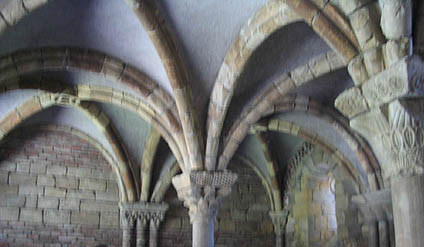
The Langon Chapel

Tomb effigy of a boy of the family of the counts of Urgel.
Spanish, First half of 14th century (Gothic Chapel)
The Cloisters is a reconstructed medieval monastery. The entire building, incorporating Romanesque and Gothic style architecture, was erected stone by stone, with materials transported from Europe. Although The Cloisters is part of the Metropolitan Museum of Art, it is located some distance away from the main Met complex. However, it is well worth taking the time to drive (or take public transport) up to the crest of a hill in Manhattan's Fort Tyron Park, where The Cloisters' ramparts rear foursquare against the sky. Soak in the tranquil ambience of monastery life as it existed in Europe over six centuries ago, while browsing through its vast collection of exquisite objets d'art— sculpture, carvings, tapestries and frescoes—which date from the twelfth to the fifteenth century. For a detailed look at the richness, variety and splendour of The Cloisters artefacts, click here
 The Langon Chapel |
 Tomb effigy of a boy of the family of the counts of Urgel. Spanish, First half of 14th century (Gothic Chapel) |
 The Pontaut Chapter House ceiling (Gascony - early 12th Century) |
 Archway: France, Narbonne - 12th Century The fantastic beasts occupying this arch were common in medieval bestiaries. The pelican, second from left which kills its young and revives them three days later with its own blood, symbolizes Christ. To the right is the basilisk which can kill with a look or a hiss and symbolizes death. The centaur, second from right has human intelligence but is ruled by animal passions |
 |
 |
|
From the Cloister of Saint-Guilhem-le-Desert:
These 12th century capitals
use acanthus-leaf motifs and decorative drill holes (Roman-style architecture) |
 Pillar embellishment |
 Corbel |
 The Unicorn Tapestries Room (The Hunt of the Unicorn) |
 |
 Pieta (Germany - 15th century) (Bonnefont Cloister) |
 Ivory panel detail (Bonnefont Cloister) |
 Stained glass (one of a series) depicting the parable of the Prodigal Son (German: Late 15th Century) (Bonnefont Cloister) |
 The Treasury |
 |
 Medieval herb garden. Right: a "sculpted" pear tree. |
 |